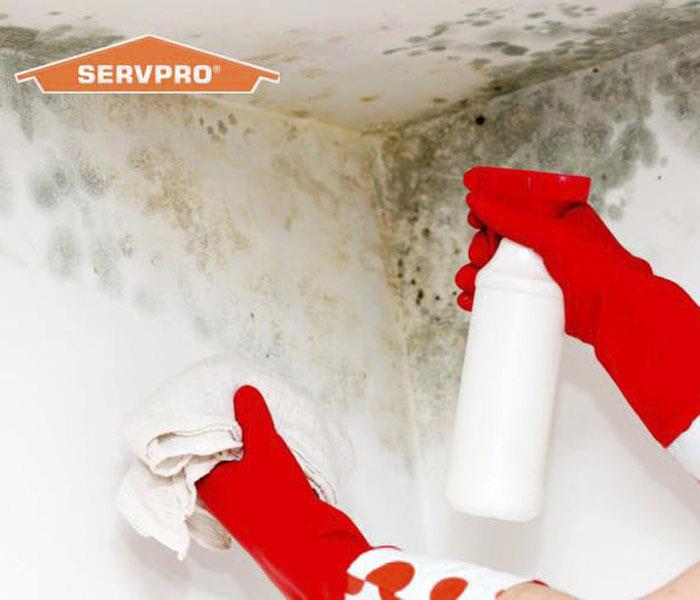The Leader Eliminating Indoor Mold
9/23/2016 (Permalink)
Is this just hype, or does mold really has a health threat? Every day is more common to hear stories of families dealing with mold growth and homes infested with fungi so toxic that they have been linked to brain damage as well as respiratory disease. It’s not a coincidence that you'll find several sites hawking do-it-yourself "mold test kits" and some other topic where mold is the main focus. Mold definitely is affecting more people every day and in a way you might not think about it.
Although mold and its spores are literally everywhere, active mold growth requires moisture. Whether on visible surfaces or hiding behind drywall, in attics, or under carpets, indoor mold grows in the presence of excessive dampness or water.
Mold comes in thousands of different strains, but only a few, including the notorious Stachybotrys chartarum, aka black mold, produces toxins.
Researchers acknowledge that these toxins are potent enough to cause serious problems in healthy people and there is plenty of evidence that all molds can potentially cause rashes, headaches, dizziness, nausea, allergic reactions (like hay fever), and asthma attacks.
Don't Let Mold move in! Members of the fungi kingdom like mushrooms they and their tiny spores need water and something living to eat. They thrive outdoors, hitchhiking into your home in dust and dirt on your clothes and shoes, on air currents, and in water that enters through cracks in walls and foundations. Once inside, they proliferate anywhere moisture exists. Notice a musty odor?
Mold spores surf the breeze more when it is hot and humid outside. Days when the temperature is high, close your windows and keep spores out, turn on and run an air conditioner (which dehumidifies). Open your windows to keep indoor humidity down and prevent spores already inside from multiplying. No matter what the weather is, avoiding mold problems is to keep dry your surroundings.
Tips to avoid molding at home
- Use good ventilation: Turn on an exhaust fan or open a nearby window while showering, bathing, running the dishwasher, or cooking, because all these activities produce water vapor. Make sure clothes dryers and all gas appliances are vented to the outside.
- Monitor moisture: Use a hygrometer (about $20 at hardware and home stores) to check the indoor humidity level. If it exceeds 55 percent—most likely in summer—lower, it by running an air conditioner or dehumidifier. In cold weather, indoor humidity should stay around 30 percent.
- Address leaks and dry waterlogged areas: When pipes burst, the roof springs a leak, or cracks in the foundation ushers water in, fix the problem ASAP. If you find a leak, dry the area pronto. "Within 24 hours, most molds are growing," says Berlin Nelson, PhD, an expert on plant pathology at North Dakota State University. Get professional help if you can't quickly manage solo, you may also contact SERVPRO at 772-334-8762 or check us out on the web, http://www.SERVPROmartincounty.com/
- Recognizing mold: Though molds are often a dark color (black or brown), they may be green, yellow, or even an incongruously delicate pink. They usually spread out in a circular pattern. Don't worry about finding out what type you're dealing with. Just get it cleaned up. If you have asthma or are allergic to mold, get someone else to do the cleanup.
How to deal with mold growth
Should mold cover more than a square foot, see professional help. The same goes for if you can smell but can't see mold—that means it's probably behind a wall or wallpaper. Don't play Bob Vila: Knocking a hole in the wall or peeling back the wallpaper can release so many spores that you can become seriously ill whether you're allergic or not.
When mold die it sheds substances that can accumulate in house dust and continue to cause sneezing, coughing, itchy eyes, and asthma attacks. After cleaning up mold, go over all surfaces with a vacuum that won't disperse it into the air, such as a central VAC or one equipped with a HEPA filter.
As we mention mold growth could be a headache if you don’t take quick actions to address it, we suggest do not let too much time pass before to get a professional that will give you useful feedback and make a deeper cleaner.
We also recommended to contact the experts in the area, SERVPRO of Martin County. Check us out on the web http://www.SERVPROmartincounty.com/ and learn more about the mold treatment or contact us at: 772-334-8762 in Martin County.






 24/7 Emergency Service
24/7 Emergency Service